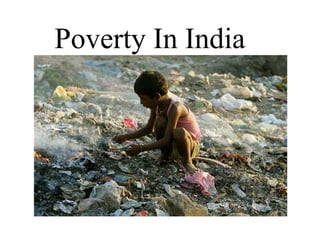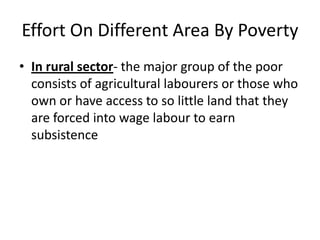Poverty in india
- 2. History of India Indian history and culture is full of richness and affluence, which undoubtedly has had a significant impact on the evolution of the society. Home to the Indus Valley civilization and a region of historic trade routes and vast empires, the Indian history is identified with its commercial and cultural wealth over the past thousands of years. Four major world religions, Hinduism, Buddhism, Jainism and Sikhism originated here.
- 3. Poverty âĒ Poverty in India has dropped sharply. âĒ From 2004-2005 to 2009-2010, the rate fell from 37.2% to 29.8%, which means around 360 million people currently live in poverty. âĒ Rural poverty has declined faster than urban poverty during this period. âĒ The Planning Commission reason for the reduction in poverty was the government's increased spending on rural welfare programmes. âĒ "This is not surprising. Such an outcome is on expected lines as this is the period when the government increased the expenditure on flagship programmes substantially," Planning Commission member Mihir Shah was quoted as saying by The Economic Times. âĒ "We gave money to the people and the result is a direct impact of that." âĒ According to the Planning Commission, rural poverty fell by 8%, compared to urban poverty which declined by 4.8%.
- 4. Cause Of Poverty? Lack of a market economy & over government regulation and red tape, known as License Raj is the main cause of poverty in India. While other Asian countries also started with the same poverty level as India after independence, India adopted a socialist centrally planned, closed economy. India has started to open its markets since the economic reforms in 1991 which has cut the poverty rate in half since then. Another cause is a high population growth rate, although demographers generally agree that this is a symptom rather than cause of poverty. While services and industry have grown at double digit figures, agriculture growth rate has dropping day by day. About sixty percent of the population depends on agriculture whereas the contribution of agriculture to the GDP is about eighteen percent. The surplus of labour in agriculture has caused many people to not have jobs. Which cause poverty.
- 5. Effort On Different Area By Poverty âĒ In rural sector- the major group of the poor consists of agricultural labourers or those who own or have access to so little land that they are forced into wage labour to earn subsistence
- 6. âĒ In urban areas- Poverty can be identified with people who are unemployed, underemployed or employed in various low productivity occupations such as porter age, street pending, etc. or employed in jobs either with insecure employed or with every low real wages
- 7. âĒ In metropolitan cities- Migrant worker are prominently amongst the poor. This segment of poverty, in fact, is the extension of the rural poverty itself. The labour absorption capacity of land is always limited, and more often than not it seems to have reached the stagnancy level.
- 8. âĒ Even after more than 50 years of Independence India still has the world's largest number of poor people in a single country. âĒ Of its nearly 1 billion inhabitants, an estimated 260.3 million are below the poverty line, of which 193.2 million are in the rural areas and 67.1 million are in urban areas. More than 75% of poor people reside in villages. âĒ Poverty level is not uniform across India. The poverty level is below 10% in states like Delhi, Goa, and Punjab etc.
- 9. War against poverty in India âĒ The problem of reducing the poverty of India is referred to elsewhere. The object of this article is to show the present economic position . Some of the things which have been done or are proposed, in order to ensure progress. âĒ NEW DELHI: In what could turn out to be its calling card for the 2014 general elections, the government is finalizing a Rs 7,000 crore scheme to give one mobile phone to every family living below the poverty line.
- 10. âĒ The scheme may be funded from the telecom department's universal service obligation (USO) funds. According to a source, 50% of the cost is likely to come from the bidder who gets the right to provide the service and the remaining from the USO fund. The fund is meant to be used to meet USO aims by providing access to phone services to people in rural and remote areas at affordable prices. The resources for its implementation are raised through a service levy fixed at 5% of the adjusted gross revenue of all telecom service providers except the pure value added service providers like internet, voice mail, email etc.
- 11. Statistics âĒ 50% of Indians donât have proper shelter. âĒ 70% donât have access to decent toilets (which inspires a multitude of bacteria to host their own disease party). âĒ 35% of households donât have a nearby water source. âĒ 85% of villages donât have a secondary school (how can this be the same government claiming 9% growth?). âĒ Over 40% of these same villages donât have proper roads connecting them.
- 12. What to do? âĒ Rapid economic growth. âĒ Stepping up agricultural growth in the less developed regions. âĒ Evolving new technology to step up production in rained agriculture. âĒ Social development. âĒ Infrastructural development. âĒ Accelerating employment in the informal rural non- agricultural sector. âĒ Improving the consciousness and education levels of the poor. âĒ Strengthening of various beneficiary-oriented programmes.
- 13. âĒ India also needs a more effective tax system as its private sector grows. âĒ Access to markets and education for everyone
- 15. References âĒ www.google.com âĒ Book - Poverty in India Bibhuti Bhushan Malik âĒ www.thp.org âĒ www.indexmundi.com















